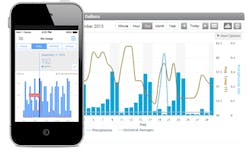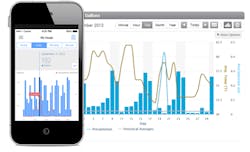Reaching for the Cloud: How Web-Based Software Services are Revolutionizing Water Utility Management
By Kristie Anderson
Water utilities are increasingly moving past manual and touch read devices in favor of automatic meter reading (AMR), advanced metering infrastructure (AMI) and most recently, advanced metering analytics (AMA). This transition allows utilities to move from capturing a monthly or quarterly meter reading for billing purposes only to a more data-driven approach for improved decision-making.
This evolution began with walk-by/drive-by technology. Next came AMI technology, which provides hourly meter reading data that can be used proactively to help improve customer service, increase operational efficiency and provide end users with a better understanding of their water consumption.
Shifting to an AMI fixed network system can also yield a dramatic decrease in labor requirements specific to meter reading, reductions in costs related to meter reader injury, and an increase in the accuracy of meter reading recording. AMI systems also provide reductions in vehicle expense and fuel and, because more detailed information is now available to the utility staff, it often provides faster resolution of consumer calls and complaints about high bills.
While this technology evolution can provide great benefits, it has historically presented the utility with a new set of operational challenges, particularly related to the management of AMI communications infrastructure and analytics software and hardware. New technologies and business models, however, are making it far easier for water utilities to move to the next step: AMA.
Cloud-Based Software
Web-based software services -- more commonly called cloud computing or Software as a Service (SaaS) -- are being implemented globally by users in virtually all types of organizations, including manufacturing, government, services, retail, and water utilities. Cloud-based software services are bringing about rapid and diverse changes to how a water utility operates and how data is used. As new systems often require new technology resources to operate and support, utilities are finding cloud computing to be a viable alternative to investing in server-based meter data management systems (MDM).
Cloud-based or SaaS platforms share several major characteristics:
- Quick deployment
- No hardware to purchase
- Expert maintenance of the system so utilities can focus on their core competency
- Automatically implemented software updates
- Rapid elasticity or expansion capability as utility's needs change
- Subscription pricing that provides a pay-as-you-go option
These characteristics allow organizations to rapidly build IT resources through cloud-based software services, making it easier and less costly to adapt to changing utility requirements. The software applications are "hosted" by the solutions vendor in secure data centers, eliminating the need to install and maintain computer hardware and software at the utility. The utility simply has to provide a personal computer with a web browser to access the secure application software via the Internet. Having the software and data hosted offsite also leaves the utility's critical metering data less susceptible to natural disasters.
Historically, MDM systems often required software updates, and on occasion, the purchase and installation of a completely new version of software. With the increased functionality, more users within the utility may require access, often meaning additional licenses need to be purchased.
However, with cloud-based systems, software improvements are automatically updated by the solutions provider, requiring no effort on the part of the utility. In addition, the costs of these software improvements are included in the base subscription, meaning the utility can always be current with the most advanced software features without additional cost or effort.
Managed Solution Model
Metering suppliers have changed the paradigm for utility meter data management. Vendors now offer solutions that include a hands-off approach for the utility with regard to the data collection equipment, computer hardware and software applications. This new approach, referred to as a "managed solution," offers several benefits. The solutions vendor installs and maintains the data collection equipment, allowing the utility to relieve itself from the responsibility of installation and maintenance of everything except the meters and endpoints. With this approach, the software applications are "hosted" by the vendor.
In the traditional approach, the utility usually assumes responsibility for implementing and managing the system. Historically, this includes utility-owned and maintained infrastructure in which data collectors or gateways are permanently installed on building roofs, light poles, water towers, or other structures. This requires the utility to develop new skills to manage and maintain these systems.
In contrast, in a provider-managed, cloud-based system, the solutions provider assumes the responsibility for operation and maintenance of the system beyond the meters and meter communications endpoints. This approach provides a flexible solution that reduces the number of resources required to operate and maintain the meter reading system, freeing personnel to be deployed to support other critical areas of the utility operation. Compared to a traditional system, staff requirements are decreased with a cloud-based managed solution.
Subscription Fees
The traditional fixed network often requires the full investment in hardware and software early in the project in anticipation of the eventual full system deployment. By contrast, with managed solutions, a subscription fee is generally charged to the utility on a monthly basis and replaces the upfront capital and long-term operating expenses associated with a traditional fixed network system. This provides for a much more favorable net present value (NPV) compared to a traditional AMI project.
Another advantage of the subscription fee model is that the fees are based on the actual number of meter endpoints in the system for each particular month (i.e., a pay-as-you-go approach). Predictable subscription fees paid over the life of the system are in stark contrast to the traditional model, where a very large portion of the costs is paid up front and unknown costs may occur during the life of the system.
Conclusion
AMA provides utilities with additional data to proactively manage their operations and enhance customer relationships. This evolution to a more utility-centric system made up of cloud-based, managed solutions means the benefits of AMA are now more attainable than ever before.
For a detailed review of the differences between traditional, utility-based systems and managed, cloud-based solutions, as well as an NPV comparison, visit www.waterworld.com/whitepapers to receive a copy of the informative white paper, http://www.waterworld.com/whitepapers/2014/11/how-the-cloud-is-revolutionizing-the-future-of-water-utility-management-understanding-the-differences-between-managed-cloud-based-software-solutions-and-traditional-in-house-solutions-for-water-meter-data-management.html "How the Cloud is Revolutionizing the Future of Water Utility Management: Understanding the Differences Between Managed Cloud-based Software Solutions and Traditional In-House Solutions for Water Meter Data Management."
About the Author: Kristie Anderson is a product marketing manager at Badger Meter. She has over 20 years of experience in marketing and product management, with extensive expertise in adapting new technology to maximize customer value. In her current role, she is responsible for the BEACON Advanced Metering Analytics Managed Solution. She holds degrees in marketing management and business administration from the School of Business at the University of Wisconsin-Madison.
More WaterWorld Current Issue Articles
More WaterWorld Archives Issue Articles

